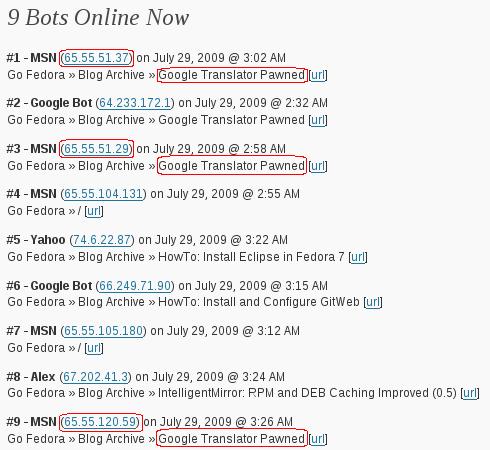There is a vulnerability in the way Google authentication service works. Whenever you login to any of the Google’s online services like GMail, Orkut, Groups, Docs, Youtube, Calendar etc., you are redirected to an authentication server which authenticates against the entered username and password and redirect back to the required service (GMail, Youtube etc.) setting the session variables.
Now, if you are able to grab the url used to set the session variables, you can login as the user to whom that url belongs from any machine on the Internet (need not be the machine belonging to the same subnet) without entering the username and password of the user.
The proxy servers in the organizations can be used to exploit this vulnerability. Squid is the most popular proxy server used. In the default configuration, squid strips the query terms of a url before logging. So, this vulnerability can’t be exploited. But if you turn off the stripping mechanism by adding the line shown below, then squid will log the complete url.
So, after turning stripping mechanism off, the log will contain urls which will look like this
http://www.google.co.in/accounts/SetSID?ssdc=1&sidt=Q5UrfB0BAAA%3D.oHVGErODzffQ%2Bms%2FOKfk53g5naReDKehRNHOBsmJlBu3VTNXjF03SbgX%2FVEEhmImhR4mlu5IAAjM%2BdbuXvMMSIb0oU8IGCYpnLcSNkbCIrG%2BQnm81YmX5%2Brcrq7U6Qx65%2F1yaQ2NzgmKD94jg0Iw13iXDen3qD5qn6L%2FhmmYWwTrcOeuTzGbO%2BAehpjEU3mrWapRafaq3b4kxyigJ68s8QrGQqZTINNE%2Bs%2BoIkZWmGt5kNzoT8fkVAsWJeu3CKFkxj4oVMngeDvpwb1nyFpsJCltOzmAr46fTxVJSpvQdx0%3D.BMLtjUdIDCcuszktZSvYzA%3D%3D&continue=http%3A%2F%2Fwww.orkut.com%2FRedirLogin.aspx%3Fmsg%3D0%26ts%3D1226148773097%3A1226148773386%3A1226148774868%26auth%3DDQAAAIcAAAC1pPE1QT4chKgrU4B3oyKZrQRkEVPtYlclpESQoXV_d9x9gdoe75Z0hfJ_22Pn5tVMR7j-uV5YCps3NB48L0bFlDeX-4PGHVT6Loztp_ru3tAy_gxDa9_YAEbz4d9CO4wD2VTKtzax9zvpGgrnJVZQfoWPkkIomUmxDtVGoH7g3fA3UjS0vdBJ2PJtgFMElso |
http://www.google.co.in/accounts/SetSID?ssdc=1&sidt=Q5UrfB0BAAA%3D.oHVGErODzffQ%2Bms%2FOKfk53g5naReDKehRNHOBsmJlBu3VTNXjF03SbgX%2FVEEhmImhR4mlu5IAAjM%2BdbuXvMMSIb0oU8IGCYpnLcSNkbCIrG%2BQnm81YmX5%2Brcrq7U6Qx65%2F1yaQ2NzgmKD94jg0Iw13iXDen3qD5qn6L%2FhmmYWwTrcOeuTzGbO%2BAehpjEU3mrWapRafaq3b4kxyigJ68s8QrGQqZTINNE%2Bs%2BoIkZWmGt5kNzoT8fkVAsWJeu3CKFkxj4oVMngeDvpwb1nyFpsJCltOzmAr46fTxVJSpvQdx0%3D.BMLtjUdIDCcuszktZSvYzA%3D%3D&continue=http%3A%2F%2Fwww.orkut.com%2FRedirLogin.aspx%3Fmsg%3D0%26ts%3D1226148773097%3A1226148773386%3A1226148774868%26auth%3DDQAAAIcAAAC1pPE1QT4chKgrU4B3oyKZrQRkEVPtYlclpESQoXV_d9x9gdoe75Z0hfJ_22Pn5tVMR7j-uV5YCps3NB48L0bFlDeX-4PGHVT6Loztp_ru3tAy_gxDa9_YAEbz4d9CO4wD2VTKtzax9zvpGgrnJVZQfoWPkkIomUmxDtVGoH7g3fA3UjS0vdBJ2PJtgFMElso
Replace .co.in with your tld specific to your country. If you paste this url in any browser, it’ll directly log you in and you can do whatever you want to that account. Remember that all such urls remains valid only for two minutes. So, if you use that url after two minutes, it’ll lead nowhere.
At the time of writing this post Orkut, Google Docs, Google Calendar, Google Books and Youtube are vulnerable.
So, make sure your squid has stripping mechanism turned on and your squid server is properly firewalled.
You can watch the Video proof for Orkut on Blip.tv, Youtube.

